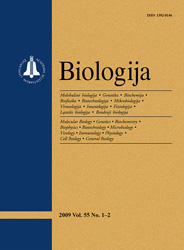 ISSN 1392-0146 ISSN 2029-0578 (online) |
2009 m. Nr. 3-4 Donor-specific transfusions as a way of tolerance induction to living donor kidney transplant
We aimed at evaluating the efficacy of the donor-specific transfusions (DST) in living kidney transplantations (Tx) performed in 1992–2000. Nineteen patients (pts) received DST 1–3 times with a two-week interval under CsA or AZA in the course of DST. One pt (5.3%) produced a donor-specific antibody after the first DST, one pt was not transplanted because of the donor’s disease. Seventeen transplanted pts were compared with a non-DST group of 47 pts: 43 of them obtained grafts from relatives and 4 from spouses. The groups were comparable the recipients’ age, the donors’ age, the male / female ratio, HLA mismatches, time on dialysis, the number of re-transplantations, percentage of sensitized pts, the panel-reactive antibody (PRA ≥15–50%). The maintenance immunosuppressive therapy was the same in both groups. We did not reveal significant differences in actuarial graft survival, calculated by Kaplan–Meier, at 1, 5 and 10 years. In the DST group it was 100%, 93.8%, 87.1% and in the control group 91.5%, 87.3%, 70.5%, respectively. The group of DST contained significantly less pts that developed acute rejection episodes during the first year than the control group (11.8% of pts vs 46.8%, χ2 = 6.5415, p < 0.02). The proportion of pts with an excellent graft function (serum creatinine <130 μmol/l) at 1 and 10 years in the DST group was 52.9%, 38.5% and in the control group 33.3% and 28.0%, respectively. Our results demonstrate that in spite of an unavoidable low risk of sensitization, a beneficial effect of DST – a significantly lower incidence of acute rejection, tendency for a better graft survival and graft function and the absence of donor-specific antibodies within a long follow-up period – has been observed. Keywords: allograft rejection, donor-specific transfusion, graft function, graft survival rate, living kidney transplantation |
Issues:
2011 - Vol.57 No. 1, No. 2, No. 3 2010 - Vol.56 No. 1-4 2009 - Vol.55 No. 1-2, No. 3-4 2008 - Vol.54 No. 1, No. 2, No. 3, No. 4 2007 - Vol.53 No. 1, No. 2, No. 3, No. 4 2006 No. 1, No. 2, No. 3, No. 4 2005 No. 1, No. 2, No. 3, No. 4 2004 No. 1, No. 2, No. 3, No. 4 2003 No. 1, No. 2, No. 3, No. 4 2002 No. 1, No. 2, No. 3, No. 4 2001 No. 1, No. 2, No. 3, No. 4 |